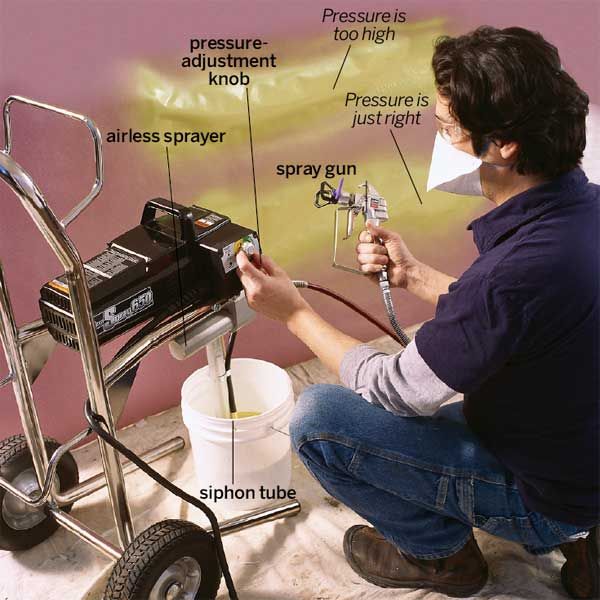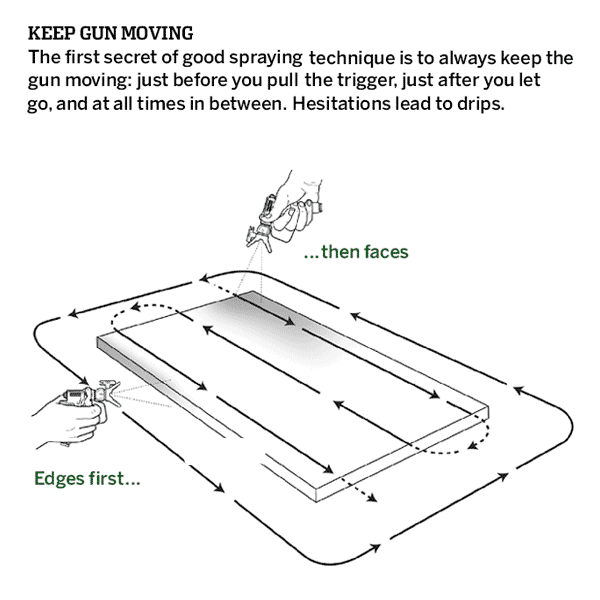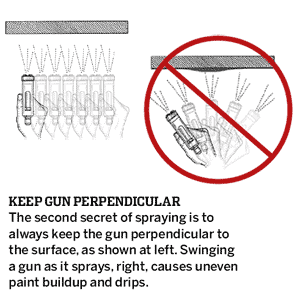


Spraying latex paint is one of the fastest and most efficient ways to achieve a smooth, professional finish on various surfaces. Whether you’re tackling a large interior project or refreshing your home’s exterior, mastering the art of spray painting can save you time and produce excellent results.
In this guide, we’ll walk you through the process of spraying latex paint, from selecting the right equipment to perfecting your technique and troubleshooting common issues.
Understanding Latex Paint and Spray Equipment
Before starting the spray painting process, you should first understand the basics of latex paint and the equipment you’ll be using. This knowledge will help you make informed decisions and achieve better results.
What Is Latex Paint?
Latex paint is a water-based paint that has become increasingly popular due to its durability, quick drying time, and easy clean-up. Unlike oil-based paints, latex paint is less prone to yellowing over time and emits fewer volatile organic compounds (VOCs), making it a more environmentally friendly option.
Types of Paint Sprayers for Latex Paint
There are several types of paint sprayers suitable for latex paint, each with its own advantages:
- Airless sprayers: The most common for latex paint and can handle thicker formulations without thinning
- Compressed air sprayers: Traditional sprayers that work well with thinned latex paint but can produce more overspray
- HVLP (High Volume Low Pressure) sprayers: Ideal for smaller projects and fine finishes but may require thinning of latex paint
Choosing the Right Sprayer for Your Project
When selecting a paint sprayer for your latex paint project, consider the following factors:
- Budget: Airless sprayers are typically more expensive but offer versatility for various projects.
- Finish: HVLP sprayers often provide a finer finish for detailed work.
- Paint viscosity: Thicker latex paints work best with airless sprayers.
- Project size: Larger projects benefit from airless sprayers, while HVLP sprayers may be best for smaller tasks.
Preparing for Your Latex Spray Painting Project
Proper preparation will help you achieve professional results when spray painting with latex paint. Taking the time to set up your work area and gather the necessary supplies will help ensure a smooth and successful project.
Safety Gear and Precautions
When working with spray paint, safety should be your top priority. Essential safety gear includes:
- Gloves
- Protective clothing (long sleeves and pants)
- Respirator mask
- Safety goggles
You should also take the time to ensure proper ventilation in your work area to minimize exposure to paint fumes and overspray.
Preparing Your Work Area
Before you begin spraying, take the following steps to protect your surroundings:
- Remove or cover all furniture and fixtures.
- Use drop cloths to protect floors and any remaining items.
- Tape off windows, doors, and trim with painter’s tape and plastic sheeting.
- For exterior projects, cover plants and outdoor furniture.
Thinning Latex Paint for Spraying
While airless sprayers can typically handle unthinned latex paint, other sprayer types may require thinning for optimal performance. To thin latex paint:
- Check your sprayer’s manual for recommended viscosity.
- Add water in small increments (about 10% of the paint volume).
- Mix thoroughly and test the consistency.
- Continue adding water gradually until you achieve the desired consistency.
- Remember that over-thinning can affect the paint’s coverage and durability, so be cautious not to add too much water.
Setting Up Your Latex Paint Sprayer
Proper setup of your paint sprayer is crucial for achieving the best results with latex paint. Follow these steps to ensure your equipment is ready for use.
Priming the Sprayer
Priming your sprayer helps remove air from the system and ensures smooth paint flow. To prime your sprayer, fill the paint container with your prepared latex paint. Then, turn on the sprayer and adjust the pressure to the lowest setting.
Point the spray gun into a waste bucket and pull the trigger until the paint flows steadily. Finally, release the trigger and increase the pressure slightly.
Adjusting Spray Pressure
Proper pressure settings are essential for achieving an even spray pattern. To set the right pressure, start with the lowest recommended pressure setting and test spray on a piece of cardboard or scrap material. From there, gradually increase the pressure until you achieve a consistent spray pattern without spitting or tailing.
The ideal pressure setting will vary depending on the paint viscosity and the specific sprayer model you use.
Selecting the Proper Tip Size
Choosing the correct tip size helps guarantee optimal paint atomization and coverage. For latex paint:
- Use a tip size between 0.013 and 0.017 inches for most interior projects.
- Larger tip sizes (0.017 to 0.021 inches) are better for exterior surfaces or thicker paints.
Consult your paint manufacturer’s recommendations for the best tip size for your specific product.
Latex Spray Painting Techniques
Developing proper spray painting techniques helps achieve a smooth, professional finish with latex paint.
Proper Gun Handling and Distance
To achieve the best results when spraying latex paint:
- Hold the spray gun perpendicular to the surface, about 12 to 14 inches away.
- Keep your arm straight and move the entire arm, not just your wrist.
- Maintain a consistent distance from the surface throughout the spraying motion.
Achieving Even Coverage
For even coverage when spraying latex paint:
- Start your spray pattern slightly before the edge of the surface.
- Move the gun in a smooth, steady motion parallel to the surface.
- Release the trigger just after passing the opposite edge.
- Overlap each pass by 50% to ensure complete coverage.
The Box-Coat Technique
You can also utilize the box-coat technique, which helps achieve uniform coverage on large surfaces. To execute the box-coat technique, follow these simple steps:
- Apply horizontal strokes across the entire surface.
- Once dry, apply vertical strokes over the same area.
- This cross-hatch pattern ensures even coverage and helps eliminate streaks or missed spots.
Spraying Different Surfaces With Latex Paint
Different surfaces require slightly different approaches when spraying latex paint. Here’s how to tackle some common surfaces in your home:
Walls and Ceilings
When spraying walls and ceilings, start in the corner and work across the surface. Use horizontal strokes for walls and parallel strokes for ceilings, and keep a wet edge to avoid lap marks. Pay extra attention to corners and edges to ensure even coverage.
Doors and Cabinets
For doors and cabinets, first, remove hardware and sand surfaces lightly if needed. Start with the edges, then move to the faces. Use light, even coats to avoid drips and runs, and allow each coat to dry completely before applying the next.
Exterior Surfaces
When spraying exterior surfaces, choose a calm day with low humidity for best results.
Start at the top of the surface and work your way down. Pay extra attention to areas prone to weathering, such as trim and siding joints. Apply two coats for better protection and durability.
Troubleshooting Common Latex Spray Painting Issues
Even experienced painters can encounter issues when spraying latex paint. Here are some common problems and their solutions.
Dealing with Overspray
Our expert-provided tips below will help you minimize overspray:
- Move closer to the surface being painted.
- Reduce spray pressure if possible.
- Use a smaller tip size.
- Use spray shields or guards to protect adjacent areas.
Fixing Paint Spitting and Uneven Lines
If you notice paint spitting or uneven lines, try the following:
- Adjust the pressure settings.
- Check for clogs in the spray tip and clean if necessary.
- Ensure the paint is thin enough to pass through your specific sprayer.
- Replace worn spray tips.
Addressing Clogged Nozzles
To prevent and address clogged nozzles, we recommend taking the following actions:
- Clean the nozzle regularly during use.
- If a paint clog occurs, reverse the nozzle and spray into a waste bucket to clear it.
- Keep spare nozzles on hand for quick replacement if needed.
- Strain your paint before use to remove any debris.
Latex Spray Paint Clean-Up and Maintenance
Proper clean-up and maintenance of your paint sprayer will guarantee the longevity of your current paint job and its performance in future projects.
Flushing the Sprayer System
After completing your project, remove any remaining paint from the sprayer and run clean water through the system until it comes out clear.
For stubborn paint residue, use the sprayer manufacturer’s recommended cleaning solution.
Flush the system with clean water again after using any cleaning solutions.
Cleaning Tips and Spray Gun Maintenance
Here are some tips for keeping your spray gun in top condition:
- Disassemble the gun and clean all parts thoroughly.
- Lubricate moving parts as recommended by the manufacturer.
- Pay special attention to the nozzle and tip, removing all paint residue.
- Store the clean, dry sprayer in a dust-free environment.
